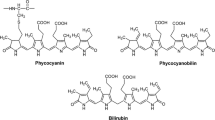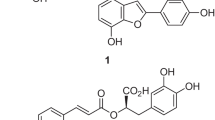Summary
Background
Soy isoflavones may affect several biochemical pathways like the synthesis of nitric oxide (•NO) and heat shock proteins (HSP) that are important factors for atherosclerosis development.
The aim of the study
The purpose of this study was to investigate the influence of soy isoflavones on the production of •NO and HSP60, HSP70 and HSC70 in experimental atherosclerosis.
Methods
One group of rabbits (New Zealand) was fed an atherogenic diet containing 27 % casein (CAS) and another group was fed the same diet supplemented with soy isoflavones (5 mg/kg/day) (ISO). Blood samples were obtained monthly and after six months of feeding, the rabbits were sacrificed and the aortas were removed.
Results
The ISO group showed a significant reduction of cholesterol in LDL (36.2 %) and in aorta (36 %), as well as, an increase of HDL-cholesterol (2.1 times) in relation to the CAS group. The concentration of •NO metabolites (NOx) in blood plasma and the levels of reactive antibodies to HSC70 in blood plasma and to HSC70 and HSP70 in aortic tissue were significantly decreased in the ISO group. Isoflavones promoted a reduction of content of HSP60, HSP70 and HSC70 in aortic arch analyzed by immunohistochemistry. The isoflavone supplementation promoted a reduction of cholesterol content in aorta (62.2 %) (p < 0.05).
Conclusions
Soy isoflavones reduced hypercholesterolemia, the production of HSP60, HSC70 and HSP70 and reactive antibodies to HSC70 in serum and to HSC70 and HSP70 in aorta, as well as, the cholesterol content in atherosclerotic lesions in rabbits fed a casein-based atherogenic diet.
Similar content being viewed by others
References
Leinonen M, Saikku P (2002) Evidence for infectious agents in cardiovascular disease and atherosclerosis. Lancet Infect Dis 2:11–17
Pockley AG (2002) Heat shock proteins, inflammation, and cardiovascular disease. Circulation 105:1012–1017
Kol A, Lichtman AH, Finberg RW, Libby P, Kurt–Jones EA (2000) Cutting edge: heat shock protein (HSP) 60 activates the innate immune response: CD14 is an essential receptor for HSP60 activation of mononuclear cells. J Immunol 164:13–17
Johnson AD, Berberian PA, Tytell M, Bond MG (1993) Atherosclerosis alters the localization of HSP70 in human and macaque aortas. Exp Mol Pathol 58:155–168
Xu Q, Kleindienst R, Schett G, Waitz W, Jindal S, Gupta RS, Dietrich H, Wick G (1996) Regression of arteriosclerotic lesions induced by immunization with heat shock protein 65–containing material in normocholesterolemic, but not hypercholesterolemic, rabbits. Atherosclerosis 123:145–155
Bason C, Corrocher R, Lunardi C, Puccetti P, Olivieri O, Girelli D, Navone R, Beri R, Millo E, Margonato A, Martinelli N, Puccetti A (2003) Interaction of antibodies against cytomegalovirus with heat–shock protein 60 in pathogenesis of atherosclerosis. Lancet 362:1971–1977
Hirvonen MR, Brune B, Lapetina EG (1996) Heat shock proteins and macrophage resistance to the toxic effects of nitric oxide. Biochem J 315(Pt 3):845–849
Luoma JS, Yla–Herttuala S (1999) Expression of inducible nitric oxide synthase in macrophages and smooth muscle cells in various types of human atherosclerotic lesions. Virchows Arch 434:561–568
Bermejo A, Zarzuelo A, Duarte J (2003) In vivo vascular effects of genistein on a rat model of septic shock induced by lipopolysaccharide. J Cardiovasc Pharmacol 42:329–338
Lahde M, Korhonen R, Moilanen E (2000) Regulation of nitric oxide production in cultured human T84 intestinal epithelial cells by nuclear factorkappa B–dependent induction of inducible nitric oxide synthase after exposure to bacterial endotoxin. Aliment Pharmacol Ther 14:945–954
Orlicek SL, Meals E, English BK (1996) Differential effects of tyrosine kinase inhibitors on tumor necrosis factor and nitric oxide production by murine macrophages. J Infect Dis 174:638–642
Kiang JG (2003) Genistein inhibits herbimycin A–induced over–expression of inducible heat shock protein 70 kDa. Mol Cell Biochem 245:191–199
Roberts DC, Stalmach ME, Khalil MW, Hutchinson JC, Carroll KK (1981) Effects of dietary protein on composition and turnover of apoproteins in plasma lipoproteins of rabbits. Can J Biochem 59:642–647
Pereira IRO, Damasceno NRT, Pereira EC, Tavares LC, Abdalla DSP (2002) Avaliação das concentraçoes plasmática e urinária de isoflavonas purificadas de soja. Revista Brasileira de Ciências Farmacêuticas 38:291–303
Havel RJ, Eder HA, Bragdon JH (1955) The distribution and chemical composition of ultracentrifugally separated lipoproteins in human serum. J Clin Invest 34:1345–1353
Franke AA, Custer LJ, Tanaka Y (1998) Isoflavones in human breast milk and other biological fluids. Am J Clin Nutr 68:1466S–1473S
Shah VP, Midha KK, Dighe S, McGilveray IJ, Skelly JP, Yacobi A, Layloff T, Viswanathan CT, Cook CE, McDowall RD (1991) Analytical methods validation: bioavailability, bioequivalence and pharmacokinetic studies. Conference report. Eur J Drug Metab Pharmacokinet 16(4):249–255
Pereira IR, Bertolami MC, Faludi AA, Campos MF, Ferderbar S, Lima ES, Aldrighi JM, Abdalla DS (2003) Lipid peroxidation and nitric oxide inactivation in postmenopausal women. Arq Bras Cardiol 80:415–423
Johnson AD, Berberian PA, Tytell M, Bond MG (1995) Differential distribution of 70–kD heat shock protein in atherosclerosis. Its potential role in arterial SMC survival. Arterioscler Thromb Vasc Biol 15:27–36
Xu Q, Kiechl S, Mayr M, Metzler B, Egger G, Oberhollenzer F, Willeit J, Wick G (1999) Association of serum antibodies to heat–shock protein 65 with carotid atherosclerosis: clinical significance determined in a follow–up study. Circulation 100:1169–1174
Lowry OH, Rosebrough NJ, Farr AL, Randall RJ (1951) Protein measurement with the folin phenol reagent. J Biol Chem 193(1):265–275
Kurowska EM, Carroll KK (1990) Essential amino acids in relation to hypercholesterolemia induced in rabbits by dietary casein. J Nutr 120:831–836
Daley SJ, Herderick EE, Cornhill JF, Rogers KA (1994) Cholesterol–fed and casein–fed rabbit models of atherosclerosis. Part 1: Differing lesion area and volume despite equal plasma cholesterol levels. Arterioscler Thromb 14:95–104
Demonty I, Lamarche B, Jones PJ (2003) Role of isoflavones in the hypocholesterolemic effect of soy. Nutr Rev 61:189–203
Greaves KA, Parks JS, Williams JK, Wagner JD (1999) Intact dietary soy protein, but not adding an isoflavone–rich soy extract to casein, improves plasma lipids in ovariectomized cynomolgus monkeys. J Nutr 129:1585–1592
Yeung J, Yu TF (2003) Effects of isoflavones (soy phyto–estrogens) on serum lipids: a meta–analysis of randomized controlled trials. Nutr J 2:15
Crouse JR 3rd, Morgan T, Terry JG, Ellis J, Vitolins M, Burke GL (1999) A randomized trial comparing the effect of casein with that of soy protein containing varying amounts of isoflavones on plasma concentrations of lipids and lipoproteins. Arch Intern Med 159:2070–2076
Mitchell JH, Gardner PT, McPhail DB, Morrice PC, Collins AR, Duthie GG (1998) Antioxidant efficacy of phytoestrogens in chemical and biological model systems. Arch Biochem Biophys 360:142–148
Samman S, Lyons Wall PM, Chan GS, Smith SJ, Petocz P (1999) The effect of supplementation with isoflavones on plasma lipids and oxidisability of low density lipoprotein in premenopausal women. Atherosclerosis 147:277–283
Tikkanen MJ, Adlercreutz H (2000) Dietary soy–derived isoflavone phytoestrogens. Could they have a role in coronary heart disease prevention? Biochem Pharmacol 60(1):1–5
Squadrito F, Altavilla D, Crisafulli A, Saitta A, Cucinotta D, Morabito N, D’anna R, Corrado F, Ruggeri P, Frisina N, Squadrito G (2003) Effect of genistein on endothelial function in postmenopausal women: a randomized, double–blind, controlled study. Am J Med 114 (6):470–476
Freyschuss A, Xiu RJ, Benthin G, Henriksson P, Bjorkhem I, Wennmalm A (1996) Dietary cholesterol induces transient changes in plasma nitrate levels in rabbits that are correlated to microcirculatory changes. Biochem Biophys Res Commun 221:107–110
Yen GC, Lai HH (2003) Inhibition of reactive nitrogen species effects in vitro and in vivo by isoflavones and soybased food extracts. J Agric Food Chem 51:7892–7900
Ruetten H, Thiemermann C, Perretti M (1999) Upregulation of ICAM–1 expression on J774. 2 macrophages by endotoxin involves activation of NF–kappaB but not protein tyrosine kinase: comparison to induction of iNOS. Mediators Inflamm 8:77–84
Posch K, Schmidt K, Graier WF (1999) Selective stimulation of L–arginine uptake contributes to shear stress–induced formation of nitric oxide. Life Sci 64(8):663–670
Armstrong R (2001) The physiological role and pharmacological potential of nitric oxide in neutrophil activation. Int Immunopharmacol 1(8):1501–1512
Pockley AG, Georgiades A, Thulin T, de Faire U, Frostegard J (2003) Serum heat shock protein 70 levels predict the development of atherosclerosis in subjects with established hypertension. Hypertension 42:235–238
Zhu J, Quyyumi AA, Wu H, Csako G, Rott D, Zalles–Ganley A, Ogunmakinwa J, Halcox J, Epstein SE (2003) Increased serum levels of heat shock protein 70 are associated with low risk of coronary artery disease. Arterioscler Thromb Vasc Biol 23:1055–1059
Kurucz I, Morva A, Vaag A, Eriksson KF, Huang X, Groop L, Koranyi L (2002) Decreased expression of heat shock protein 72 in skeletal muscle of patients with type 2 diabetes correlates with insulin resistance. Diabetes 51:1102–1109
House SD, Guidon PTJ, Perdrizet GA, Rewinski M, Kyriakos R, Bockman RS, Mistry T, Gallagher PA, Hightower LE (2001) Effects of heat shock, stannous chloride, and gallium nitrate on the rat inflammatory response. Cell Stress Chaperones 6:164–171
Xu Q, Schett G, Perschinka H, Mayr M, Egger G, Oberhollenzer F, Willeit J, Kiechl S, Wick G (2000) Serum soluble heat shock protein 60 is elevated in subjects with atherosclerosis in a general population. Circulation 102:14–20
Wright BH, Corton J, El–Nahas AM, Wood RFM, Pockley AG (2000) Elevated levels of circulating heat shock protein 70 (Hsp70) in peripheral and renal vascular disease. Heart Vessels 15:18–22
Ghayour–Mobarhan M, New SA, Lamb DJ, Starkey BJ, Livingstone C, Wang T, Vaidya N, and Ferns GA (2005) Dietary antioxidants and fat are associated with plasma antibody titers to heat shock proteins 60 : 65, and 70 in subjects with dyslipidemia. Am J Clin Nutr 81:998–1004
Svensson PA, Asea A, Englund MC, Bausero MA, Jernas M, Wiklund O, Ohlsson BG, Carlsson LM, Carlsson B (2005) Major role of HSP70 as a paracrine inducer of cytokine production in human oxidized LDL treated macrophages. Atherosclerosis. Jun 30 (Epub ahead of print)
Boersma BJ, D’Alessandro T, Benton MR, Kirk M, Wilson LS, Prasain J, Botting NP, Barnes S, Darley–Usmar VM, Patel RP (2003) Neutrophil myeloperoxidase chlorinates and nitrates soy isoflavones and enhances their antioxidant properties. Free Radic Biol Med 35(11):1417–1430
Raines EW, Ross R (1995) Biology of atherosclerotic plaque formation: possible role of growth factors in lesion development and the potential impact of soy. J Nutr 125:624S–630S
Yamakoshi J, Piskula MK, Izumi T, Tobe K, Saito M, Kataoka S, Obata A, Kikuchi M (2000) Isoflavone aglycone–rich extract without soy protein attenuates atherosclerosis development in cholesterol– fed rabbits. J Nutr 130:1887–1893
Author information
Authors and Affiliations
Corresponding author
Rights and permissions
About this article
Cite this article
Rosier Olimpio Pereira, I., Saes Parra Abdalla, D. Soy isoflavones reduce heat shock proteins in experimental atherosclerosis. Eur J Nutr 45, 178–186 (2006). https://doi.org/10.1007/s00394-005-0581-8
Received:
Accepted:
Published:
Issue Date:
DOI: https://doi.org/10.1007/s00394-005-0581-8




